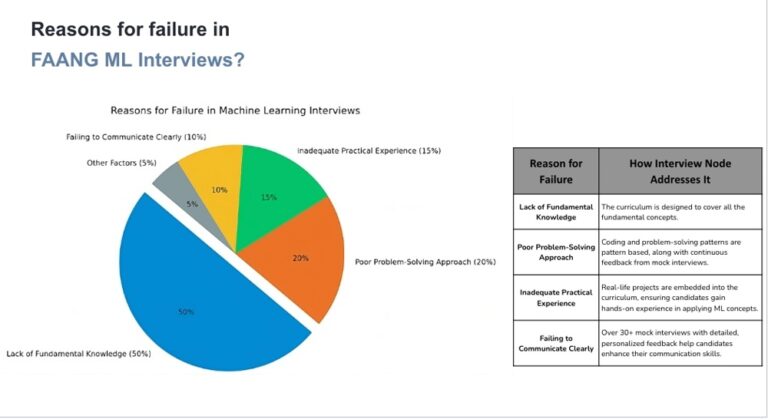Introduction
FAANG (Facebook, Amazon, Apple, Netflix, Google) machine learning Top Fail FAANG ML Interviews — And How to Beat the Odds with InterviewNode interviews are some of the most challenging in the tech industry.
They test not only your technical knowledge but also your problem-solving skills, practical experience, and
ability to communicate effectively.Despite months of preparation, many candidates fail to clear these interviews due to a few common mistakes. To avoid becoming one of the many who Reasons Engineers, it's crucial to understand what hiring teams are really looking for—and how to prepare with precision.
In this blog, we’ll explore
the top reasons candidates fail FAANG ML interviews, provide real interview
questions with examples of incorrect and correct answers, and show how
InterviewNode helps you avoid these pitfalls. Whether you’re struggling with fundamentals,
problem-solving, or communication, this guide will give you the tools to succeed.
Let’s dive in!
Section 1: Lack of Fundamental Knowledge
Why It Matters
FAANG interviews test your
understanding of core machine learning concepts, from basic algorithms to advanced mathematical principles.
Without a strong foundation, even the most experienced candidates can stumble.
Common Mistakes
Candidates often memorize
formulas and algorithms without understanding the underlying principles. This leads to incorrect or
incomplete answers during interviews.
Example Interview Question
Question:
Explain the difference between L1 and L2 regularization. Why does L1 regularization lead to sparsity?
Incorrect Answer:"L1 regularization adds the absolute value of coefficients to the loss function, and L2
adds the squared value. L1 leads to sparsity because it penalizes large coefficients."
Why It’s Wrong:This answer is incomplete. It doesn’t explain why L1 regularization leads to
sparsity or how it affects the model’s performance.
Proper Answer:"L1 regularization adds the absolute value of coefficients to the loss function, while
L2 adds the squared value. L1 leads to sparsity because it can shrink some coefficients to zero, effectively
removing those features from the model. This happens because the L1 penalty is not differentiable at zero,
causing the optimization process to push some weights to exactly zero. In contrast, L2 regularization
shrinks coefficients smoothly but rarely reduces them to zero."
How InterviewNode Helps
Structured Curriculum: Our modules cover fundamental concepts in depth, ensuring you understand
the "why" behind every algorithm and equation.
Quizzes and Assessments: Regular quizzes test your knowledge and reinforce key concepts.
Live Sessions: Instructors explain complex topics in simple terms and provide real-world
examples.
Section 2: Poor Problem-Solving Approach
Why It Matters
FAANG interviews prioritize
problem-solving skills. You need to demonstrate a structured, logical approach to tackling problems, whether
it’s designing a machine learning pipeline or optimizing an algorithm.
Common Mistakes
Candidates often jump into
coding without fully understanding the problem or fail to break it down into smaller, manageable
parts.
Example Interview Question
Question:
Design a recommendation system for a streaming platform like Netflix.
Incorrect Answer:"I would use collaborative filtering because it’s the best method for recommendations.
I’ll start coding the algorithm right away."
Why It’s Wrong:This answer lacks structure and doesn’t consider the trade-offs between different
approaches. It also doesn’t address scalability or real-world constraints.
Proper Answer:"First, I’d clarify the requirements: Are we focusing on user-user recommendations,
item-item recommendations, or both? Next, I’d consider the trade-offs between collaborative filtering and
content-based filtering. Collaborative filtering works well when we have sufficient user-item interaction
data, but it can suffer from the cold-start problem. Content-based filtering can handle new items but may
not capture user preferences as effectively. To address scalability, I’d explore matrix factorization
techniques like Singular Value Decomposition (SVD) or use deep learning models like neural collaborative
filtering. Finally, I’d discuss how to evaluate the system using metrics like precision, recall, and
RMSE."
How InterviewNode Helps
Pattern-Based Problem Solving: We teach you to recognize common problem patterns and apply structured
solutions.
Mock Interviews: Practice solving real-world problems under timed conditions.
Feedback: Detailed feedback on your problem-solving approach, coding
style, and optimization techniques.
Section 3: Inadequate Practical Experience
Why It Matters
FAANG companies want
candidates who can apply machine learning concepts to real-world problems. If your resume lacks hands-on
experience, you’re at a disadvantage.
Common Mistakes
Candidates often work on
projects that are too simple, irrelevant, or poorly presented during interviews.
Example Interview Question
Question:
Tell me about a machine learning project you’ve worked on.
Incorrect Answer:"I built a sentiment analysis model using a pre-trained library. I loaded the data, ran
the model, and got good accuracy."
Why It’s Wrong:This answer is vague and doesn’t demonstrate your understanding of the problem, the
solution, or the impact of your work.
Proper Answer:"I worked on a sentiment analysis project for a retail company to analyze customer
reviews. The goal was to identify common pain points and improve customer satisfaction. I started by
cleaning the text data, removing stopwords, and performing stemming. I experimented with several models,
including logistic regression, LSTM, and BERT. After evaluating their performance using precision, recall,
and F1-score, I chose BERT due to its superior accuracy. I also deployed the model using Flask and
integrated it into the company’s dashboard. The project helped the company identify key areas for
improvement, leading to a 15% increase in customer satisfaction."
How InterviewNode Helps
Real-Life Projects: Work on projects like recommendation systems, NLP models, and computer vision
applications.
Project Guidance: Instructors guide you through each project, ensuring you understand the
concepts and techniques.
Interview Prep: Learn how to present your projects effectively during interviews.
Section 4: Failing to Communicate Clearly
Why It Matters
Communication is a critical
skill in FAANG interviews. You need to articulate your thought process, explain complex concepts, and engage
the interviewer.
Common Mistakes
Candidates often use too
much jargon, fail to explain their thought process, or don’t structure their answers clearl
Example Interview Question
Question:
Explain how gradient descent works.
Incorrect Answer:"Gradient descent is an optimization algorithm. It updates the weights using the
gradient of the loss function."
Why It’s Wrong:This answer is too brief and doesn’t explain the intuition or steps involved in gradient
descent.
Proper Answer:"Gradient descent is an optimization algorithm used to minimize the loss function in
machine learning models. It works by iteratively updating the model’s parameters in the opposite direction
of the gradient of the loss function with respect to those parameters. Here’s how it works
step-by-step:
Initialize the model’s
parameters with random values.
Compute the gradient of
the loss function with respect to each parameter.
Update the parameters
by
subtracting the gradient multiplied by a learning rate.
Repeat steps 2 and 3
until the loss converges to a minimum.The learning rate controls the size of the steps we take
during optimization. If it’s too large, we might overshoot the minimum; if it’s too small,
convergence will be slow."
How InterviewNode Helps
Mock Interviews: Practice explaining complex concepts clearly and concisely.
Communication Training: Learn how to structure your answers and use simple language.
Feedback: Detailed feedback on your communication skills and areas
for improvement.
Section 5: Other Common Reasons for Failure
1. Lack of Preparation for Behavioral Interviews
Example Question: Tell me about a time you faced a challenge at work and how you overcame
it.
Incorrect Answer: "I had a tight deadline, so I worked overtime to finish the
project."
Proper Answer: "I was leading a team to deliver a machine learning model under a
tight deadline. We faced challenges with data quality, so I organized daily stand-ups to track progress and
delegated tasks effectively. I also collaborated with the data engineering team to clean the data faster. We
delivered the model on time, and it improved the company’s recommendation accuracy by 20%."
2. Time Management Issues
Example Question: Write code to find the longest substring without repeating
characters.Incorrect Approach: Jumping into coding without planning.
Proper Approach: Break the problem into smaller steps (e.g., sliding window technique) and write
pseudocode before coding.
3. Nervousness and Lack of Confidence
How InterviewNode Helps: We provide stress management techniques and confidence-building exercises to help you
stay calm under pressure.
Conclusion
FAANG ML interviews are
tough, but they’re not impossible. By understanding the common reasons for failure and addressing them with
the right preparation, you can significantly improve your chances of success. At InterviewNode, we’re here
to guide you every step of the way.
Ready to take the next step?
Join InterviewNode today and start your journey toward acing your FAANG ML interview. Your dream job is
closer than you think!






